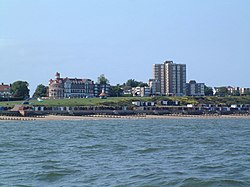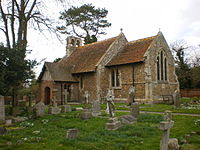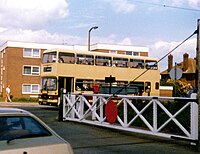Frinton-on-Sea: Difference between revisions
m clean up, typos fixed: Britian → Britain |
|||
| (One intermediate revision by one other user not shown) | |||
| Line 2: | Line 2: | ||
|county=Essex | |county=Essex | ||
|name=Frinton-on-Sea | |name=Frinton-on-Sea | ||
|picture=Frinton- | |picture=Frinton on Sea - geograph.org.uk - 234475.jpg | ||
|picture caption=The seafront at Frinton-on-Sea | |picture caption=The seafront at Frinton-on-Sea | ||
|os grid ref=TM236198 | |os grid ref=TM236198 | ||
| Line 32: | Line 32: | ||
[[File:St Mary's Church, Frinton-on-Sea - geograph.org.uk - 1577879.jpg|right|thumb|200px|St Mary's]] | [[File:St Mary's Church, Frinton-on-Sea - geograph.org.uk - 1577879.jpg|right|thumb|200px|St Mary's]] | ||
*[[Church of England]]: | *[[Church of England]]: | ||
**St Mary the Virgin, Norman in parts and once reckoned by some the smallest church in | **St Mary the Virgin, Norman in parts and once reckoned by some the smallest church in Britain. | ||
**St Mary Magdalene, built in 1928 | **St Mary Magdalene, built in 1928 | ||
*Evangelical: Gospel Chapel | *Evangelical: Gospel Chapel | ||
| Line 40: | Line 40: | ||
==The Gates== | ==The Gates== | ||
[[File:Frinton on sea 1982.jpg|right|thumb|200px|The gates in 1982]] | |||
Frinton is cut in two by the railway, and the only access to the town centre is over a level crossing. The gates are seen locally as marking the entrance to the town and the division of residents is between those "within the gates" or "outside the gates". The gates even appear on the town's badge. | Frinton is cut in two by the railway, and the only access to the town centre is over a level crossing. The gates are seen locally as marking the entrance to the town and the division of residents is between those "within the gates" or "outside the gates". The gates even appear on the town's badge. | ||
Latest revision as of 16:57, 27 January 2016
| Frinton-on-Sea | |
| Essex | |
|---|---|
 The seafront at Frinton-on-Sea | |
| Location | |
| Grid reference: | TM236198 |
| Location: | 51°49’58"N, 1°14’43"E |
| Data | |
| Population: | 5,500 |
| Post town: | Frinton-on-Sea |
| Postcode: | CO13 |
| Dialling code: | 01255 |
| Local Government | |
| Council: | Tendring |
| Parliamentary constituency: |
Harwich |
Frinton-on-Sea is a small seaside resort town in Essex, one which flowered suddenly in the Victorian period with the coming of the railway and throve in the early twentieth century, a growth matched by a decline after the War. It is now contiguous with Walton-on-the-Naze to the north along the coast.
Frinton is isolated by its position and this has perhaps contributed to the town's inward-looking perspective. It has two points of entry by road: the narrow road from Walton-on-the-Naze in the north, and a level crossing adjacent to the railway station which replaced the older gated crossing in 2009. The only other ways in are by footpath. Frinton was once geographically distinct, but housing estates now line the roads between Frinton and Walton-on-the-Naze, Kirby Cross and Kirby-Le-Soken.
The town has a sandy beach, more than a mile long, with wardens in season, and an area of sea zoned for swimming, sailing and windsurfing. The shore is lined by a promenade with several hundred beach huts. Landward from the promenade is a long greensward, popular with young and old alike, stretching from the boundary with Walton-on-Naze to the golf club in the south.
Six miles offshore lies Gunfleet Lighthouse, constructed in 1850 but abandoned in 1921.[1]
History
Until late Victorian times Frinton-on-Sea was a church, several farms and a handful of cottages. In the 1890s, the original developer of the town, Peter Bruff, was bought out by R Powell Cooper, who had already laid out the golf course.[2] Powell Cooper rejected Bruff's plans for a pier, stipulated the quality of housing to be built and prohibited boarding houses and pubs.[2] The Sea Defence Act 1903 established a project to stabilise the cliffs, with the Greensward, which separates the Esplanade from the sea, put in place to stabilise the land further.[2]
In the first half of the 20th century, the town attracted visitors from high society with a lido complete with palm trees, shopping with, Connaught Avenue, named after the Duke of Connaught and opened by his wife, being dubbed East Anglia's Bond Street, high class hotels along the Esplanade, a tennis tournament second only to Wimbledon; the Prince of Wales frequented the golf club and Winston Churchill rented a house.[2] Frinton was the last target in Britain attacked by the Luftwaffe, in 1944.[3]
Until recently there were no pubs, although there have long been bars in seafront hotels and at the golf and War Memorial clubs. The first pub, the Lock and Barrell, opened in 2000.[4]
Churches

- Church of England:
- St Mary the Virgin, Norman in parts and once reckoned by some the smallest church in Britain.
- St Mary Magdalene, built in 1928
- Evangelical: Gospel Chapel
- Free church
- Methodist
- Roman Catholic: Sacred Heart
The Gates

Frinton is cut in two by the railway, and the only access to the town centre is over a level crossing. The gates are seen locally as marking the entrance to the town and the division of residents is between those "within the gates" or "outside the gates". The gates even appear on the town's badge.
Until 2009, the level crossing gates were manually operated; at the approach of a train traffic would be stopped by guards and the gates swung closed by hand, though Network Rail were keen to replace this system with modern gates lifted automatically. Remarkably, this caused a three-year campaign by residents to save the Frinton Gates, which ended only when Network Rail replaced the gates overnight in 2009. This quixotic campaign was a central focus in the 2008 BBC Wonderland documentary The Curious World of Frinton-on-Sea.[5]
At 2am on Saturday 18 April 2009, Network Rail replaced the old wooden gates on the level crossing at the entrance to Frinton with remotely operated lifting barriers, in order to improve performance and safety, and to reduce costs.[6] The morning following the gates' removal, around a hundred people gathered to protest over the decision.[6][7]
The Frinton and Walton Heritage Trust said that "The gates are iconic. Frinton's had gates for virtually as long as it's been a town. Frinton is effectively a triangular town and is bordered on three sides by the sea, the railway line and the marshes."
Following the removal of the gates in 2009, they were held in storage by the Trust and have since been relocated.[8][9]
Frinton in popular culture
Frinton is home to the Frinton Summer Theatre Season at the McGrigor Hall every summer. Started in 1937 by the Cambridge Academic T P Hoar as an amusement whilst he studied corrosion, it quickly developed a life of its own, employing many famous actors at the start of their career. Michael Denison, Vanessa Redgrave, Timothy West, Jane Asher, David Suchet, Gary Oldman, Owen Teale, Linda Bellingham, Jack Klaff and Neil Dudgeon all started their careers at Frinton. For many years it was run by the British actor Jack Watling, and his son Giles and son-in-law Seymour Matthews. His daughters Debbie and Dilys often appeared on stage, as did 'Allo 'Allo! star John D Collins. It is now run by the actor Ed Max.
Frinton's old-fashioned nature made it the butt of music hall jokes, such as: "Harwich for the Continent, Frinton for the incontinent".[10] However, its genteel nature has ensured that property 'within the gates' is well sought after.
The Curious World of Frinton-on-Sea was a cruel documentary in the BBC's "Wonderland" series in 2008. Not a balanced assessment of the town, it was a satirical programme which looked entirely at the elderly residents and the campaign to preserve the Frinton Gates.
Frinton was used in a recent Subway Sandwiches commercial for the UK although the advert was not actually filmed in Frinton.[11]
Outside links
- Frinton and Walton Heritage Trust
- Association of Frinton Beach Hut Owners website
- Unofficial Frinton on sea website
- Frinton Golf Club website
- Essex Photos
- BIGL Radio has studios in Frinton
- Joke's over for the last resort (Ross Clark, Daily Telegraph, 19 July 2003)
References
- ↑ http://www.bobleroi.co.uk/ScrapBook/CityReunion/FortFanatics.html
- ↑ 2.0 2.1 2.2 2.3 Peers, Deborah (September 2008). "Once upon a time in... Frinton". Essex Life (Archant): pp. 88–89. http://edition.pagesuite-professional.co.uk/Launch.aspx?referral=other&pnum=&refresh=Xx310Ki2Lg80&EID=ae1ff680-f48b-4a38-9931-2ac69df9011d&skip=true. Retrieved 2009-01-18. (Registration required).
- ↑ "Frinton-on-Sea". www.clacton-on-sea-essex.co.uk. http://www.clacton-on-sea-essex.co.uk/Frinton-on-Sea.html. Retrieved 5 January 2011.
- ↑ Burkeman, Oliver (September 15, 2000). "There goes the neighbourhood". The Guardian (London: Guardian News and Media Limited). http://www.guardian.co.uk/g2/story/0,3604,368560,00.html. Retrieved 2009-01-24.
- ↑ The Curious World of Frinton-on-Sea - BBC
- ↑ 6.0 6.1 Booth, Robert (20 April 2009). "Frinton-on-Sea's historic railway gates removed 'under cover of darkness". London: The Guardian. http://www.guardian.co.uk/uk/2009/apr/20/frinton-on-sea-railway-gates. Retrieved 20 April 2009.
- ↑ "Ungated Community". London: The Daily Telegraph. 19 April 2009. http://www.telegraph.co.uk/comment/telegraph-view/5183431/Ungated-community.html. Retrieved 20 April 2009.
- ↑ Taking Action: Frinton Gates Preservation Society vs Network Rail - PR Week 24 April 2009
- ↑ Frinton-on-Sea old railway crossing gates get new home - BBC News 9 April 2012
- ↑ Michael Collins Frinton-on-Sea: last outpost of a long-forgotten Empire The Independent 5 June 2004
- ↑ Subway Advert Am I Dead? No, You're In Frinton On Sea Frinton.org 4 February 2010